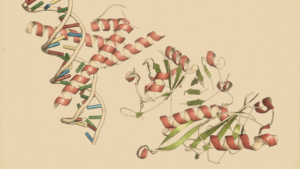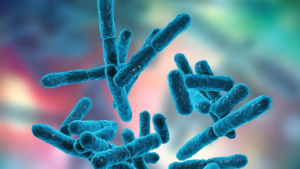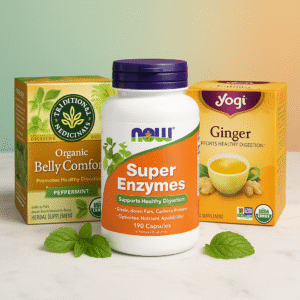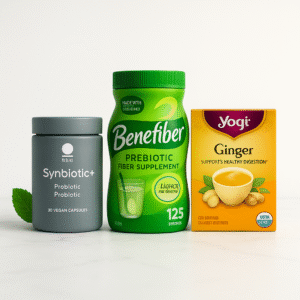Soybean: Best Vegan Protein-Rich Food for Gut Health
Explore the benefits of vegan protein-rich food for digestive wellness. Discover nutritious plant-based protein-soybeans and its role on GI support.

Soybeans, hailed as a cornerstone in vegan diets, stand out as a vegan protein-rich food pivotal for gut health.
This article delves into the multifaceted benefits of soybeans, exploring how they enhance digestive wellness and contribute to a healthy gut microbiome.
We'll examine the role of soy protein in digestion, the advantages of fermented soy products, and the impact of soy foods on reducing colorectal cancer risk.
As a versatile and nutritious plant-based protein source, soybeans offer a harmonious blend of health benefits, making them an essential component of any plant-based diet focused on gastrointestinal health.

Main findings
- Fermented soy milk shows more favorable changes in the gut microbiome compared to unfermented soy milk, likely due to probiotic effects.
- Soy proteins, at high levels of intake, may induce greater cytotoxic and genotoxic damage to intestinal tissue compared to dairy protein intake. However, adding fermentable fibers to the diet can mitigate these effects.
- There is either a lack of association or a small inverse association between soy/soy isoflavone intake and colorectal cancer risk.
- High intakes of soy isoflavones and phytoestrogens are associated with a small but significant reduction in colorectal cancer risk, particularly in Asian populations.
Keywords: soy; gastrointestinal; colorectal cancer; vegan protein-rich food; microbiome; soy protein
Welcome to Soy's World
The Science of Vegan Protein-Rich Foods: Soybeans, Gut Health, and More
Soybeans: A Nutrient Powerhouse
Soybeans (Glycine max) are a nutritional powerhouse, offering a rich source of plant-based protein.
Notably, they are the only plant protein containing all essential amino acids necessary for human health.
While most of the global soybean production goes into animal feeds, soy-based products such as soy milk, tofu, edamame, and tempeh have been gaining popularity in human diets.
In recent years, soy production has doubled, reflecting the growing demand for plant-based protein sources and global sustainability recommendations A Trusted Source
Ritchie, H.; Roser, M. Forests and Deforestation. Available online: https://ourworldindata.org/forests-and-deforestation (accessed on 6 September 2021).[https://ourworldindata.org/forests-and-deforestation] A Trusted Source
Voora, V.; Larrea, C.; Bermudez, S. Global Market Report: Soybeans; International Institute for Sustainable Development: Winnipeg, MB, Canada, 2020. [Google Scholar] A Trusted Source
United Nations Department of Economic and Social Affairs. The 17 Goals. Available online: https://sdgs.un.org/goals (accessed on 12 October 2021).[https://sdgs.un.org/goals].
Soybeans stand out among beans and legumes for several nutritional reasons.
They boast twice the protein content of other common legumes and contain all nine essential amino acids.
Leucine, a vital amino acid for muscle protein synthesis and maintenance, is present in soybeans at levels comparable to fish and eggs A Trusted Source
Food Standards Australia New Zealand. AUSNUT 2011–13—Australian Food Composition Database; FSANZ: Canberra, Australia, 2014. A Trusted Source
van Vliet, S.; Burd, N.A.; van Loon, L.J. The Skeletal Muscle Anabolic Response to Plant- versus Animal-Based Protein Consumption. J. Nutr. 2015, 145, 1981–1991. [Google Scholar, CrossRef, PubMed] A Trusted Source
van Loon, L.J. Leucine as a pharmaconutrient in health and disease. Curr. Opin. Clin. Nutr. Metab. Care 2012, 15, 71–77. [Google Scholar, CrossRef, PubMed].
Additionally, soybeans offer dietary fiber in the form of oligosaccharides and other non-starch polysaccharides, which promote intestinal fermentation.
High levels of polyunsaturated fatty acids, including essential omega-6 and omega-3 fatty acids, make soybeans a standout among legumes.
Furthermore, soybeans provide essential micronutrients like calcium, iron, and zinc, often lacking in plant-based diets.
The efficient absorption of calcium from soybeans makes them an ideal dairy alternative, leading to the availability of soy-based milk, cheese, and yogurt worldwide A Trusted Source
Food Standards Australia New Zealand. AUSNUT 2011–13—Australian Food Composition Database; FSANZ: Canberra, Australia, 2014. A Trusted Source
Medic, J.; Atkinson, C.; Hurburgh, C.R., Jr. Current Knowledge in Soybean Composition. J. Am. Oil Chem. Soc. 2014, 91, 363–384. [Google Scholar, CrossRef] A Trusted Source
Huisman, M.M.H.; Schols, H.A.; Voragen, A.G.J. Enzymatic degradation of cell wall polysaccharides from soybean meal. Carbohyd. Polym. 1999, 38, 299–307. [Google Scholar, CrossRef] A Trusted Source
Grieshop, C.M.; Kadzere, C.T.; Clapper, G.M.; Flickinger, E.A.; Bauer, L.L.; Frazier, R.L.; Fahey, G.C. Chemical and nutritional characteristics of United States soybeans and soybean meals. J. Agric. Food Chem. 2003, 51, 7684–7691. [Google Scholar, CrossRef, PubMed] A Trusted Source
Tian, L.M.; Scholte, J.; Scheurink, A.J.W.; van den Berg, M.; Bruggeman, G.; Bruininx, E.; de Vos, P.; Schols, H.A.; Gruppen, H. Effect of oat and soybean rich in distinct non-starch polysaccharides on fermentation, appetite regulation and fat accumulation in rat. Int. J. Biol. Macromol. 2019, 140, 515–521. [Google Scholar, CrossRef] A Trusted Source
O’Keefe, S.; Bianchi, L.; Sharman, J. Soybean Nutrition. SM J. Nutr. Metab. 2015, 1, 9. [Google Scholar].
Soybeans and the Misconceptions About Isoflavones
Early investigations into soybeans and soy products primarily centered around their isoflavone content.

Pure Power: Non-GMO Super Concentrated Isoflavones
Due to their phytoestrogenic nature, concerns arose that high soy consumption might negatively impact hormonal function.
However, subsequent scientific research has debunked these fears.
A review concluded that soy isoflavones do not interfere with the endocrine system's function A Trusted Source
Messina, M.; Mejia, S.B.; Cassidy, A.; Duncan, A.; Kurzer, M.; Nagato, C.; Ronis, M.; Rowland, I.; Sievenpiper, J.; Barnes, S. Neither soyfoods nor isoflavones warrant classification as endocrine disruptors: A technical review of the observational and clinical data. Crit. Rev. Food Sci. Nutr. 2021, 62, 5824–5885. [Google Scholar, CrossRef].
Furthermore, they do not adversely affect thyroid function, hormones in men and women, or reproductive parameters.
There is limited evidence suggesting that soy isoflavones may reduce menopausal hot flashes and lower the risk of breast and prostate cancer A Trusted Source
Bolaños-Díaz, R.; Zavala-Gonzales, J.C.; Mezones-Holguín, E.; Francia-Romero, J. Soy extracts versus hormone therapy for reduction of menopausal hot flushes: Indirect comparison. Menopause 2011, 18, 825–829. [Google Scholar, CrossRef] A Trusted Source
Franco, O.H.; Chowdhury, R.; Troup, J.; Voortman, T.; Kunutsor, S.; Kavousi, M.; Oliver-Williams, C.; Muka, T. Use of Plant-Based Therapies and Menopausal Symptoms: A Systematic Review and Meta-analysis. JAMA 2016, 315, 2554–2563. [Google Scholar, CrossRef] A Trusted Source
Taku, K.; Melby, M.K.; Kronenberg, F.; Kurzer, M.S.; Messina, M. Extracted or synthesized soybean isoflavones reduce menopausal hot flash frequency and severity: Systematic review and meta-analysis of randomized controlled trials. Menopause 2012, 19, 776–790. [Google Scholar, CrossRef, PubMed] A Trusted Source
World Cancer Research Fund; American Institute for Cancer Research. Diet, Nutrition, Physical Activity and Cancer: A Global Perspective. Continuous Update Project Report; World Cancer Research Fund: London, UK, 2018. [Google Scholar].
However, it remains unclear whether these effects result from soy isoflavones themselves or from other nutritional components in soybeans, such as polyunsaturated fats, fiber, vitamins, and minerals A Trusted Source
Messina, M.; Mejia, S.B.; Cassidy, A.; Duncan, A.; Kurzer, M.; Nagato, C.; Ronis, M.; Rowland, I.; Sievenpiper, J.; Barnes, S. Neither soyfoods nor isoflavones warrant classification as endocrine disruptors: A technical review of the observational and clinical data. Crit. Rev. Food Sci. Nutr. 2021, 62, 5824–5885. [Google Scholar, CrossRef].
Soy and Gut Health
The human gut plays a crucial role in overall health, and the composition of the gut microbiome influences gastrointestinal (GI) health.
Microbial dysbiosis, characterized by an imbalance favoring pro-inflammatory species, is linked to various diseases, including inflammatory bowel disease, obesity, and cardiovascular conditions.
Nutrients from soy products, like soy milk and textured soy proteins, resist digestion in the upper digestive tract and serve as substrates for microbes residing in the large intestine A Trusted Source
Huang, H.; Krishnan, H.B.; Pham, Q.; Yu, L.L.; Wang, T.T. Soy and gut microbiota: Interaction and implication for human health. J. Agric. Food Chem. 2016, 64, 8695–8709. [Google Scholar, CrossRef, PubMed] A Trusted Source
Brestoff, J.R.; Artis, D. Commensal bacteria at the interface of host metabolism and the immune system. Nat. Immunol. 2013, 14, 676–684. [Google Scholar, CrossRef].
These nutrients include proteins, isoflavones, and fermentable non-starch polysaccharides like cellulose, hemicellulose, and pectin, as well as oligosaccharides like raffinose and stachyose.
The nutrient content and bioavailability in soy-based foods vary depending on the formulation and processing methods A Trusted Source
Valdes, A.M.; Walter, J.; Segal, E.; Spector, T.D. Role of the gut microbiota in nutrition and health. BMJ 2018, 361, k2179. [Google Scholar, CrossRef, PubMed] A Trusted Source
Gentile, C.L.; Weir, T.L. The gut microbiota at the intersection of diet and human health. Science 2018, 362, 776–780. [Google Scholar, CrossRef, PubMed].

For instance, textured soy protein has a significantly higher oligosaccharide content than other soy foods, like tempeh, soy cheese, and milk A Trusted Source
Biesiekierski, J.R.; Rosella, O.; Rose, R.; Liels, K.; Barrett, J.S.; Shepherd, S.J.; Gibson, P.R.; Muir, J.G. Quantification of fructans, galacto-oligosacharides and other short-chain carbohydrates in processed grains and cereals. J. Hum. Nutr. Diet. 2011, 24, 154–176. [Google Scholar, CrossRef] A Trusted Source
Tuck, C.; Ly, E.; Bogatyrev, A.; Costetsou, I.; Gibson, P.; Barrett, J.; Muir, J. Fermentable short chain carbohydrate (FODMAP) content of common plant-based foods and processed foods suitable for vegetarian- and vegan-based eating patterns. J. Hum. Nutr. Diet. 2018, 31, 422–435. [Google Scholar, CrossRef] A Trusted Source
U.S. Department of Agriculture. Food Data Central; Agricultural Research Service: Washington, DC, USA, 2019..
Moreover, about 10% of dietary protein resists digestion in the small intestine and reaches the colon, where it becomes a nitrogen and energy source for specific bacteria, supporting their growth in the gut A Trusted Source
Cummings, J. Carbohydrate and Protein Digestion: The Substrates Available for Fermentation. In The Large Intestine in Nutrition and Disease; Danone Institute: Brussels, Belgium, 1997; pp. 15–42. [Google Scholar] A Trusted Source
Cummings, J.; Macfarlane, G. The control and consequences of bacterial fermentation in the human colon. J. Appl. Bacteriol. 1991, 70, 443–459. [Google Scholar, CrossRef].
Fermented soy products, such as tofu, contain microbes that could function as probiotics if they escape digestion in the upper gut A Trusted Source
Arroyo, G.; Penas, E.; Pedrazuela, A.; Prestamo, G. Intestinal microbiota in rats fed with tofu (soy curd) treated under high pressure. Eur. Food Res. Technol. 2005, 220, 395–400. [Google Scholar, CrossRef].
A practical way to enhance these benefits is through probiotic soy yogurt. Rich in live cultures, this yogurt supports a healthy gut microbiome, aligning with the benefits of soy's dietary fibers and fermentable polysaccharides.
Soy and GI Health: Current Evidence
Although previous reviews have explored the effects of soy on the gut microbiota, they have not fully assessed its impact on critical parameters like microbial metabolites and GI health.
This review aims to fill that gap by evaluating the existing evidence regarding the effects of soy foods, including soy milk, soy protein, oligosaccharides, and isoflavones, on GI health.
A comprehensive approach that incorporates systematic reviews, umbrella reviews, randomized clinical trials, and animal feeding studies was used to summarize the findings A Trusted Source
Huang, H.; Krishnan, H.B.; Pham, Q.; Yu, L.L.; Wang, T.T. Soy and gut microbiota: Interaction and implication for human health. J. Agric. Food Chem. 2016, 64, 8695–8709. [Google Scholar, CrossRef, PubMed].
Behind the Scenes
In a comprehensive study, a wide-ranging search in PubMed identified 1024 relevant publications on soy consumption and gut health.
These included human studies, reviews, meta-analyses, as well as animal and in vitro models.
After screening, 20 reviews/meta-analyses and 33 other publications were chosen for a detailed review.
The research delves into how soy protein, various soy products, and key soy components impact microbial composition, microbial metabolites, and a specific GI disease, colorectal cancer (CRC).
The Soy Milk Saga
Unveiling the Mysteries of Soy Milk and Gut Bacteria
Epidemiological evidence suggests that soy milk can influence the gut microbiome, particularly when comparing fermented and unfermented products.
A cross-sectional study A Trusted Source
Liu, Y.; Ajami, N.J.; El-Serag, H.B.; Hair, C.; Graham, D.Y.; White, D.L.; Chen, L.; Wang, Z.; Plew, S.; Kramer, J.; et al. Dietary quality and the colonic mucosa-associated gut microbiome in humans. Am. J. Clin. Nutr. 2019, 110, 701–712. [Google Scholar, CrossRef] examined the effects of milk intake on the microbiome, revealing that higher consumption of milk and soy beverages was linked to increased levels of beneficial gut bacteria like Faecalibacterium, Bifidobacterium, and Parabacteroides.
However, it's important to note that the study did not differentiate between milk types, making it likely that these effects were primarily attributed to dairy milk.
In three randomized controlled trials (RCTs) investigating unfermented soy milk's impact on gut microbes, results were inconsistent A Trusted Source
Cheng, I.C.; Shang, H.F.; Lin, T.F.; Wang, T.H.; Lin, H.S.; Lin, S.H. Effect of fermented soy milk on the intestinal bacterial ecosystem. World J. Gastroenterol. 2005, 11, 1225–1227. [Google Scholar, CrossRef, PubMed].
One study observed an increase in Lactobacillus levels after a 2-week intervention A Trusted Source
Cheng, I.C.; Shang, H.F.; Lin, T.F.; Wang, T.H.; Lin, H.S.; Lin, S.H. Effect of fermented soy milk on the intestinal bacterial ecosystem. World J. Gastroenterol. 2005, 11, 1225–1227. [Google Scholar, CrossRef, PubMed], while another involving infants reported no changes after 4 weeks A Trusted Source
Piacentini, G.; Peroni, D.; Bessi, E.; Morelli, L. Molecular characterization of intestinal microbiota in infants fed with soymilk. J. Pediatr. Gastroenterol. Nutr. 2010, 51, 71–76. [Google Scholar, CrossRef], and a study with overweight and obese men found decreased levels of Lactobacillus and Bifidobacterium after 3 months A Trusted Source
Fernandez-Raudales, D.; Hoeflinger, J.L.; Bringe, N.A.; Cox, S.B.; Dowd, S.E.; Miller, M.J.; Gonzalez de Mejia, E. Consumption of different soymilk formulations differentially affects the gut microbiomes of overweight and obese men. Gut Microbes 2012, 3, 490–500. [Google Scholar, CrossRef, PubMed].
Conversely, the consumption of fermented soy milk was associated with increased levels of Bifidobacterium and Lactobacillus in two RCTs A Trusted Source
Cheng, I.C.; Shang, H.F.; Lin, T.F.; Wang, T.H.; Lin, H.S.; Lin, S.H. Effect of fermented soy milk on the intestinal bacterial ecosystem. World J. Gastroenterol. 2005, 11, 1225–1227. [Google Scholar, CrossRef, PubMed] A Trusted Source
Inoguchi, S.; Ohashi, Y.; Narai-Kanayama, A.; Aso, K.; Nakagaki, T.; Fujisawa, T. Effects of non-fermented and fermented soybean milk intake on faecal microbiota and faecal metabolites in humans. Int. J. Food Sci. Nutr. 2012, 63, 402–410. [Google Scholar, CrossRef].
These findings align with studies in rodents, where fecal Bifidobacterium, Lactobacillus, and/or Bacteroides increased in animals fed fermented soy milk A Trusted Source
Wang, Z.L.; Bao, Y.; Zhang, Y.; Zhang, J.C.; Yao, G.Q.; Wang, S.Q.; Zhang, H.P. Effect of Soymilk Fermented with Lactobacillus plantarum P-8 on Lipid Metabolism and Fecal Microbiota in Experimental Hyperlipidemic Rats. Food Biophys. 2013, 8, 43–49. [Google Scholar, CrossRef] A Trusted Source
Bedani, R.; Pauly-Silveira, N.D.; Roselino, M.N.; de Valdez, G.F.; Rossi, E.A. Effect of fermented soy product on the fecal microbiota of rats fed on a beef-based animal diet. J. Sci. Food Agric. 2010, 90, 233–238. [Google Scholar, CrossRef].
These results suggest that microbes present in fermented soy milk may have probiotic effects.
There's limited evidence suggesting that nutrients from soy milk may have a prebiotic effect on the large bowel.
One study, using a cholesterol-induced colonic inflammation rat model, found that replacing casein with soy milk in the diet reversed diet-induced dysbiosis by altering the Firmicutes (Coprococcus, Lactobacillus, Blautia genera) to Bacteroidetes (Barnesiella genus) ratio A Trusted Source
Lee, S.-M.; Han, H.W.; Yim, S.Y. Beneficial effects of soy milk and fiber on high cholesterol diet-induced alteration of gut microbiota and inflammatory gene expression in rats. Food Funct. 2015, 6, 492–500. [Google Scholar, CrossRef, PubMed].

Soy Milk: A Fighter Against Inflammation?
Two studies involving individuals with type-2 diabetes found that soy milk intake did not significantly impact C-reactive peptide and cytokine levels when compared to baseline measures A Trusted Source
Feizollahzadeh, S.; Ghiasvand, R.; Rezaei, A.; Khanahmad, H.; Sadeghi, A.; Hariri, M. Effect of Probiotic Soy Milk on Serum Levels of Adiponectin, Inflammatory Mediators, Lipid Profile, and Fasting Blood Glucose among Patients with Type II Diabetes Mellitus. Probiotics Antimicrob. Proteins 2017, 9, 41–47. [Google Scholar, CrossRef] or cow's milk consumption A Trusted Source
Miraghajani, M.S.; Esmaillzadeh, A.; Najafabadi, M.M.; Mirlohi, M.; Azadbakht, L. Soy Milk Consumption, Inflammation, Coagulation, and Oxidative Stress Among Type 2 Diabetic Patients with Nephropathy. Diabetes Care 2012, 35, 1981–1985. [Google Scholar, CrossRef].
However, research using rat models of inflammatory bowel disease produced inconsistent findings, suggesting that soy milk might improve various indicators of intestinal cell damage and inflammation A Trusted Source
Bitzer, Z.T.; Wopperer, A.L.; Chrisfield, B.J.; Tao, L.; Cooper, T.K.; Vanamala, J.; Elias, R.J.; Hayes, J.E.; Lambert, J.D. Soy protein concentrate mitigates markers of colonic inflammation and loss of gut barrier function in vitro and in vivo. J. Nutr. Biochem. 2017, 40, 201–208. [Google Scholar, CrossRef, PubMed] A Trusted Source
Kawahara, M.; Nemoto, M.; Nakata, T.; Kondo, S.; Takahashi, H.; Kimura, B.; Kuda, T. Anti-inflammatory properties of fermented soy milk with Lactococcus lactis subsp. lactis S-SU2 in murine macrophage RAW264. 7 cells and DSS-induced IBD model mice. Int. Immunopharmacol. 2015, 26, 295–303. [Google Scholar, CrossRef, PubMed].
To delve deeper into this potential, a study is currently in progress.
It's investigating whether soy milk consumption (250 mL/day for 4 weeks) by individuals with ulcerative colitis, compared to no dietary changes, can alleviate symptoms and reduce inflammation.
This investigation aims to shed light on how soy milk may influence gut microbiota and its role in addressing inflammatory bowel conditions A Trusted Source
Sadeghi, O.; Milajerdi, A.; Siadat, S.D.; Keshavarz, S.A.; Sima, A.R.; Vahedi, H.; Adibi, P.; Esmaillzadeh, A. Effects of soy milk consumption on gut microbiota, inflammatory markers, and disease severity in patients with ulcerative colitis: A study protocol for a randomized clinical trial. Trials 2020, 21, 565. [Google Scholar, CrossRef].
The Power of Soy Proteins
How Soy Proteins Affect Our Gut Microbes
In three dietary intervention studies, rodents consuming soy protein concentrate or isolates exhibited higher microbial diversity, seen as a marker of gut health, and changes in specific microbial species compared to those on casein-based diets A Trusted Source
Valdes, A.M.; Walter, J.; Segal, E.; Spector, T.D. Role of the gut microbiota in nutrition and health. BMJ 2018, 361, k2179. [Google Scholar, CrossRef, PubMed] A Trusted Source
An, C.; Kuda, T.; Yazaki, T.; Takahashi, H.; Kimura, B. Caecal fermentation, putrefaction and microbiotas in rats fed milk casein, soy protein or fish meal. Appl. Microbiol. Biotechnol. 2014, 98, 2779–2787. [Google Scholar, CrossRef] A Trusted Source
Butteiger, D.N.; Hibberd, A.A.; McGraw, N.J.; Napawan, N.; Hall-Porter, J.M.; Krul, E.S. Soy Protein Compared with Milk Protein in a Western Diet Increases Gut Microbial Diversity and Reduces Serum Lipids in Golden Syrian Hamsters. J. Nutr. 2016, 146, 697–705. [Google Scholar, CrossRef] A Trusted Source
Tamura, K.; Sasaki, H.; Shiga, K.; Miyakawa, H.; Shibata, S. The Timing Effects of Soy Protein Intake on Mice Gut Microbiota. Nutrients 2019, 12, 87. [Google Scholar, CrossRef, PubMed] A Trusted Source
Le Chatelier, E.; Nielsen, T.; Qin, J.; Prifti, E.; Hildebrand, F.; Falony, G.; Almeida, M.; Arumugam, M.; Batto, J.M.; Kennedy, S.; et al. Richness of human gut microbiome correlates with metabolic markers. Nature 2013, 500, 541–546. [Google Scholar, CrossRef].
One study by An and colleagues found that rats on a soy protein diet had increased levels of Enterococcus and decreased levels of Lactobacilli and Ruminococcus when compared to those on diets with fish meal or milk casein A Trusted Source
An, C.; Kuda, T.; Yazaki, T.; Takahashi, H.; Kimura, B. Caecal fermentation, putrefaction and microbiotas in rats fed milk casein, soy protein or fish meal. Appl. Microbiol. Biotechnol. 2014, 98, 2779–2787. [Google Scholar, CrossRef].
Lactobacillus, known for its role in metabolic balance, may potentially reduce antigen transfer from gut bacteria to the host and alleviate inflammation related to metabolic syndrome A Trusted Source
Arora, T.; Anastasovska, J.; Gibson, G.; Tuohy, K.; Sharma, R.K.; Bell, J.; Frost, G. Effect of Lactobacillus acidophilus NCDC 13 supplementation on the progression of obesity in diet-induced obese mice. Br. J. Nutr. 2012, 108, 1382–1389. [Google Scholar, CrossRef] A Trusted Source
Zhang, C.; Zhang, M.; Wang, S.; Han, R.; Cao, Y.; Hua, W.; Mao, Y.; Zhang, X.; Pang, X.; Wei, C. Interactions between gut microbiota, host genetics and diet relevant to development of metabolic syndromes in mice. ISME J. 2010, 4, 232–241. [Google Scholar, CrossRef] A Trusted Source
Zhao, L. The gut microbiota and obesity: From correlation to causality. Nat. Rev. Microbiol. 2013, 11, 639–647. [Google Scholar, CrossRef, PubMed] A Trusted Source
Cani, P.D.; Amar, J.; Iglesias, M.A.; Poggi, M.; Knauf, C.; Bastelica, D.; Neyrinck, A.M.; Fava, F.; Tuohy, K.M.; Chabo, C. Metabolic endotoxemia initiates obesity and insulin resistance. Diabetes 2007, 56, 1761–1772. [Google Scholar, CrossRef, PubMed].
Another study in rats, however, showed that soy protein-fed rats had a similar abundance of Lactobacillus compared to those fed casein and beef meat A Trusted Source
Zhu, Y.; Shi, X.; Lin, X.; Ye, K.; Xu, X.; Li, C.; Zhou, G. Beef, Chicken, and Soy Proteins in Diets Induce Different Gut Microbiota and Metabolites in Rats. Front. Microbiol. 2017, 8, 1395. [Google Scholar, CrossRef].
Meanwhile, when soy protein concentrate or isolate was added to a Western-style diet for golden Syrian hamsters, the most significant differences in microbial abundance were observed within the Bacteroidetes phylum, with lower relative abundances of Bacteroidaceae and Porphyromonadaceae compared to milk protein-fed groups A Trusted Source
Butteiger, D.N.; Hibberd, A.A.; McGraw, N.J.; Napawan, N.; Hall-Porter, J.M.; Krul, E.S. Soy Protein Compared with Milk Protein in a Western Diet Increases Gut Microbial Diversity and Reduces Serum Lipids in Golden Syrian Hamsters. J. Nutr. 2016, 146, 697–705. [Google Scholar, CrossRef].
To conveniently increase your intake of these beneficial proteins, consider incorporating soy protein powder into your daily diet. This powder is an easy way to boost your protein intake while enjoying the full range of amino acids that
Exploring the Role of Soy in Fermentation and Bile Acids
In animal studies, researchers have delved into how soy proteins affect microbial fermentation products, particularly short-chain fatty acids (SCFAs) and lipopolysaccharides (LPS).
SCFAs are essential for colonocytes and have a role in regulating T regulatory (Treg) cells while benefiting various organs, including the liver, adipose tissue, and the brain A Trusted Source
Pascale, A.; Marchesi, N.; Marelli, C.; Coppola, A.; Luzi, L.; Govoni, S.; Giustina, A.; Gazzaruso, C. Microbiota and metabolic diseases. Endocrine 2018, 61, 357–371. [Google Scholar, CrossRef].
Soy protein diets in mice and rats have shown an increase in fecal SCFAs compared to casein-based diets A Trusted Source
Tamura, K.; Sasaki, H.; Shiga, K.; Miyakawa, H.; Shibata, S. The Timing Effects of Soy Protein Intake on Mice Gut Microbiota. Nutrients 2019, 12, 87. [Google Scholar, CrossRef, PubMed] A Trusted Source
Toden, S.; Bird, A.R.; Topping, D.L.; Conlon, M.A. Differential effects of dietary whey, casein and soya on colonic DNA damage and large bowel SCFA in rats fed diets low and high in resistant starch. Br. J. Nutr. 2007, 97, 535–543. [Google Scholar, CrossRef].
Another study revealed that rats consuming a fiber-enriched diet with soy protein had higher caecal acetic acid levels A Trusted Source
Bai, G.; Ni, K.; Tsuruta, T.; Nishino, N. Dietary Casein and Soy Protein Isolate Modulate the Effects of Raffinose and Fructooligosaccharides on the Composition and Fermentation of Gut Microbiota in Rats. J. Food Sci. 2016, 81, H2093–H2098. [Google Scholar, CrossRef].
However, soy protein's impact on LPS, which can trigger inflammation, remains uncertain.
Some studies have suggested that rats consuming soy protein have higher levels of LPS-binding protein in the liver and serum compared to casein-fed rats A Trusted Source
Zhu, Y.; Shi, X.; Lin, X.; Ye, K.; Xu, X.; Li, C.; Zhou, G. Beef, Chicken, and Soy Proteins in Diets Induce Different Gut Microbiota and Metabolites in Rats. Front. Microbiol. 2017, 8, 1395. [Google Scholar, CrossRef] A Trusted Source
Zhu, Y.; Lin, X.; Zhao, F.; Shi, X.; Li, H.; Li, Y.; Zhu, W.; Xu, X.; Li, C.; Zhou, G. Meat, dairy and plant proteins alter bacterial composition of rat gut bacteria. Sci. Rep. 2015, 5, 15220. [Google Scholar, CrossRef], but more investigation is needed to clarify this.
Bile acids are crucial in the gastrointestinal tract, linking gut microbiota to hepatic and intestinal metabolism and affecting various aspects of gut health, including GI motility, intestinal permeability, and the risk of colorectal cancer A Trusted Source
Jia, W.; Xie, G.; Jia, W. Bile acid-microbiota crosstalk in gastrointestinal inflammation and carcinogenesis. Nat. Rev. Gastroenterol. Hepatol. 2018, 15, 111–128. [Google Scholar, CrossRef].
Soy protein consumption appears to modulate bile acid metabolism.
In mice on a high-fat diet, soy protein isolate led to an enlarged caecal bile acid pool with an elevated secondary/primary bile acid ratio compared to casein-fed mice A Trusted Source
Watanabe, K.; Igarashi, M.; Li, X.; Nakatani, A.; Miyamoto, J.; Inaba, Y.; Sutou, A.; Saito, T.; Sato, T.; Tachibana, N.; et al. Dietary soybean protein ameliorates high-fat diet-induced obesity by modifying the gut microbiota-dependent biotransformation of bile acids. PLoS ONE 2018, 13, e0202083. [Google Scholar, CrossRef, PubMed].
This diet also altered the gut microbiome, potentially influencing bile acid biotransformation.
However, research in rats with hepatic steatosis showed different results, with soy protein isolate reducing microbes associated with secondary bile acid production A Trusted Source
Panasevich, M.R.; Schuster, C.M.; Phillips, K.E.; Meers, G.M.; Chintapalli, S.V.; Wankhade, U.D.; Shankar, K.; Butteiger, D.N.; Krul, E.S.; Thyfault, J.P.; et al. Soy compared with milk protein in a Western diet changes fecal microbiota and decreases hepatic steatosis in obese OLETF rats. J. Nutr. Biochem. 2017, 46, 125–136. [Google Scholar, CrossRef].
Soy Proteins: Friends or Foes of GI Health?
Numerous controlled studies in rats have explored the effects of soy protein-rich diets (>20% weight) compared to dairy proteins on gastrointestinal (GI) health.
The majority (5 out of 8) of these studies suggest that soy protein diets might have adverse effects on various GI measures.
For instance, one study revealed that rats fed soybean protein for 9 days experienced higher epithelial cell damage, increased colonic cell proliferation rates, and greater faecal water cytotoxicity compared to rats on casein-based diets during the same period A Trusted Source
Govers, M.J.; Lapre, J.A.; De Vries, H.T.; Van der Meer, R. Dietary soybean protein compared with casein damages colonic epithelium and stimulates colonic epithelial proliferation in rats. J. Nutr. 1993, 123, 1709–1713. [Google Scholar, CrossRef].
Similarly, another study found that high dietary intakes of soy protein isolate (25%, but not 15% weight) increased the genotoxicity of the colonic environment, resulting in heightened colonic DNA damage A Trusted Source
Toden, S.; Bird, A.R.; Topping, D.L.; Conlon, M.A. Differential effects of dietary whey, casein, and soya on colonic DNA damage and large bowel SCFA in rats fed diets low and high in resistant starch. Br. J. Nutr. 2007, 97, 535–543. [Google Scholar, CrossRef].
Furthermore, in rat carcinogenesis models, soy proteins were associated with increased numbers of aberrant crypt foci (ACF), considered pre-cancerous lesions, or intestinal tumors.
Soy protein concentrate (low in isoflavones) increased ACF numbers, while high isoflavone soy products reduced total ACF compared to a starch control diet.
Interestingly, the timing of soy protein consumption also played a role, with increased colonic ACF numbers when soy protein was consumed before carcinogen exposure but reduced numbers after 6 weeks of consumption A Trusted Source
Gee, J.; Noteborn, H.; Polley, A.; Johnson, I. Increased induction of aberrant crypt foci by 1, 2-dimethylhydrazine in rats fed diets containing purified genistein or genistein-rich soya protein. Carcinogenesis 2000, 21, 2255–2259. [Google Scholar, CrossRef, PubMed] A Trusted Source
Helms, J.; Gallaher, D. The effect of dietary soy protein isolate and genistein on the development of preneoplastic lesions (aberrant crypts) in rats. J. Nutr. 1995, 125, 713S–716S. [Google Scholar] A Trusted Source
Davies, M.J.; Bowey, E.A.; Adlercreutz, H.; Rowland, I.R.; Rumsby, P.C. Effects of soy or rye supplementation of high-fat diets on colon tumour development in azoxymethane-treated rats. Carcinogenesis 1999, 20, 927–931. [Google Scholar, CrossRef, PubMed].
However, it's essential to consider that these potential adverse effects of soy protein on GI health may be influenced by dietary fiber present in soy-based foods or other dietary sources.
Studies have shown that the addition of resistant starch or xylo-oligosaccharides to soy protein diets reduced genotoxic damage in the colon and decreased genotoxicity when soy protein was part of a fermented material A Trusted Source
Toden, S.; Bird, A.R.; Topping, D.L.; Conlon, M.A. Differential effects of dietary whey, casein and soya on colonic DNA damage and large bowel SCFA in rats fed diets low and high in resistant starch. Br. J. Nutr. 2007, 97, 535–543. [Google Scholar, CrossRef] A Trusted Source
Christophersen, C.T.; Petersen, A.; Licht, T.R.; Conlon, M.A. Xylo-oligosaccharides and inulin affect genotoxicity and bacterial populations differently in a human colonic simulator challenged with soy protein. Nutrients 2013, 5, 3740–3756. [Google Scholar, CrossRef].
Additionally, combining soy protein with raffinose increased caecum IgA concentration, potentially helping prevent pathogenic bacterial invasion in the large intestine A Trusted Source
Bai, G.; Ni, K.; Tsuruta, T.; Nishino, N. Dietary Casein and Soy Protein Isolate Modulate the Effects of Raffinose and Fructooligosaccharides on the Composition and Fermentation of Gut Microbiota in Rats. J. Food Sci. 2016, 81, H2093–H2098. [Google Scholar, CrossRef].
Soy Oligosaccharides: Boosting Your Gut's Microbial Activity
In the only human clinical study available A Trusted Source
Kapadia, S.A.; Raimundo, A.H.; Grimble, G.K.; Aimer, P.; Silk, D.B. Influence of three different fiber-supplemented enteral diets on bowel function and short-chain fatty acid production. JPEN J. Parenter. Enter. Nutr. 1995, 19, 63–68. [Google Scholar, CrossRef, PubMed], individuals consuming soy oligosaccharide fiber showed increased levels of faecal short-chain fatty acids (SCFA) and butyric acid compared to those on other fiber diets.
Importantly, there were no significant changes in bowel function indicators.
Animal and in vitro studies further support these findings.
A pig-feeding trial demonstrated that soybean oligosaccharides increased SCFA concentrations, boosted intestinal microbiota diversity, and promoted the growth of beneficial bacteria like Bifidobacterium sp., Faecalibacterium prausnitzii, and Roseburia A Trusted Source
Zhou, X.L.; Kong, X.F.; Lian, G.Q.; Blachier, F.; Geng, M.M.; Yin, Y.L. Dietary supplementation with soybean oligosaccharides increases short-chain fatty acids but decreases protein-derived catabolites in the intestinal luminal content of weaned Huanjiang mini-piglets. Nutr. Res. 2014, 34, 780–788. [Google Scholar, CrossRef].
It also reduced potentially harmful bacteria and decreased intestinal inflammation markers.
Additionally, an in vitro study showed that specific gut microbes, including Bifidobacteria, can utilize soybean oligosaccharides, while putrefactive bacteria like Escherichia coli and Clostridium perfringens cannot A Trusted Source
Inoguchi, S.; Ohashi, Y.; Narai-Kanayama, A.; Aso, K.; Nakagaki, T.; Fujisawa, T. Effects of non-fermented and fermented soybean milk intake on faecal microbiota and faecal metabolites in humans. Int. J. Food Sci. Nutr. 2012, 63, 402–410. [Google Scholar, CrossRef].
These findings suggest that soy oligosaccharides may hold promise for enhancing GI health, although further research is needed to fully understand their potential benefits.
Isoflavones Uncovered: Soy's Secret Ingredient for a Healthy Gut
Isoflavones, naturally present in soy, possess antibacterial properties.
However, their effects on the gut microbiome vary among individuals, depending on their ability to metabolize specific isoflavones, particularly daidzein, which can be converted to equol in the intestine by certain gut microbes A Trusted Source
Mayo, B.; Vázquez, L.; Flórez, A.B. Equol: A Bacterial Metabolite from The Daidzein Isoflavone and Its Presumed Beneficial Health Effects. Nutrients 2019, 11, 2231. [Google Scholar, CrossRef, PubMed].
In postmenopausal women, three clinical trials explored how equol-producing capabilities influenced the response to soy consumption.
One study involving short-term soy milk and soy germ intake revealed that the gut microbiota changes depended on equol metabolism.
Strong equol producers exhibited reduced levels of unfavorable Clostridium coccoides-Eubacterium rectale bacteria but increased levels of gut-inflammation-associated sulphate-reducing bacteria A Trusted Source
Bolca, S.; Possemiers, S.; Herregat, A.; Huybrechts, I.; Heyerick, A.; De Vriese, S.; Verbruggen, M.; Depypere, H.; De Keukeleire, D.; Bracke, M.; et al. Microbial and dietary factors are associated with the equol producer phenotype in healthy postmenopausal women. J. Nutr. 2007, 137, 2242–2246. [Google Scholar, CrossRef].
Another one-week study found that soy bar consumption increased Bifidobacterium abundance, particularly in equol producers A Trusted Source
Nakatsu, C.H.; Armstrong, A.; Clavijo, A.P.; Martin, B.R.; Barnes, S.; Weaver, C.M. Fecal bacterial community changes associated with isoflavone metabolites in postmenopausal women after soy bar consumption. PLoS ONE 2014, 9, e108924. [Google Scholar, CrossRef].
A two-month study with gelified soy extract showed that isoflavones stimulated various beneficial microbes, with the extent of stimulation depending on equol excretion.
Notably, the bifidogenic effect was more prolonged in equol producers A Trusted Source
Clavel, T.; Fallani, M.; Lepage, P.; Levenez, F.; Mathey, J.; Rochet, V.; Serezat, M.; Sutren, M.; Henderson, G.; Bennetau-Pelissero, C.; et al. Isoflavones and functional foods alter the dominant intestinal microbiota in postmenopausal women. J. Nutr. 2005, 135, 2786–2792. [Google Scholar, CrossRef].
For a targeted approach to enjoying the benefits of isoflavones, consider trying isoflavone supplements. These supplements offer a concentrated and controlled way to integrate these compounds into your diet.
Soy and Colon Health: Can Soy Foods Reduce Cancer Risk?
Colorectal cancer (CRC) ranks among the most prevalent cancers worldwide, with its risk closely linked to diet.
While some dietary elements like whole grains, dairy, and fiber-rich foods have been shown to lower CRC risk, the impact of soy remains less clear, although there have been hints of its potential benefits in CRC prevention A Trusted Source
World Cancer Research Fund; American Institute for Cancer Research. Diet, Nutrition, Physical Activity and Cancer: A Global Perspective. Continuous Update Project Report; World Cancer Research Fund: London, UK, 2018. [Google Scholar].
An umbrella review of CRC prevention highlighted the mixed evidence on soy and CRC risk.
Three meta-analyses of observational studies were reviewed, with two reporting a slight reduction in CRC risk associated with soy consumption A Trusted Source
Zhu, B.; Sun, Y.; Qi, L.; Zhong, R.; Miao, X. Dietary legume consumption reduces risk of colorectal cancer: Evidence from a meta-analysis of cohort studies. Sci. Rep. 2015, 5, 8797. [Google Scholar, CrossRef] A Trusted Source
Tse, G.; Eslick, G.D. Soy and isoflavone consumption and risk of gastrointestinal cancer: A systematic review and meta-analysis. Eur. J. Nutr. 2016, 55, 63–73. [Google Scholar, CrossRef, PubMed], while one found no significant link A Trusted Source
Woo, H.D.; Park, S.; Oh, K.; Kim, H.J.; Shin, H.R.; Moon, H.K.; Kim, J. Diet and cancer risk in the Korean population: A meta-analysis. Asian Pac. J. Cancer Prev. 2014, 15, 8509–8519. [Google Scholar, CrossRef, PubMed].
Overall, the certainty of evidence regarding soy's impact on CRC risk was deemed very low, although it might offer a modest reduction in colon cancer risk A Trusted Source
Chapelle, N.; Martel, M.; Toes-Zoutendijk, E.; Barkun, A.N.; Bardou, M. Recent advances in clinical practice: Colorectal cancer chemoprevention in the average-risk population. Gut 2020, 69, 2244–2255. [Google Scholar, CrossRef, PubMed].
The inconsistency in soy's protective association with CRC could be attributed to various factors leading to study variability.
These factors include imprecise measurement of soy consumption and phytoestrogen intake, limited diversity in soy products studied, reliance on questionnaire-based retrospective studies prone to recall bias, and differences in soy composition between Asian and Western diets.
Interestingly, the inverse correlation between soy intake and GI cancer seemed stronger in countries like China and Japan, where soy consumption is more diverse and higher overall A Trusted Source
Tse, G.; Eslick, G.D. Soy and isoflavone consumption and risk of gastrointestinal cancer: A systematic review and meta-analysis. Eur. J. Nutr. 2016, 55, 63–73. [Google Scholar, CrossRef, PubMed].
Moreover, several meta-analyses delved into the relationship between specific soy components, particularly isoflavones or phytoestrogens, and CRC risk.
Some found that soy isoflavone consumption was associated with a reduced CRC risk, particularly in Asian populations A Trusted Source
Yu, Y.; Jing, X.; Li, H.; Zhao, X.; Wang, D. Soy isoflavone consumption and colorectal cancer risk: A systematic review and meta-analysis. Sci. Rep. 2016, 6, 25939. [Google Scholar, CrossRef].
Others reported an inverse association between phytoestrogen intake and CRC risk, although this was more pronounced in case-control studies A Trusted Source
Jiang, R.; Botma, A.; Rudolph, A.; Hüsing, A.; Chang-Claude, J. Phyto-oestrogens and colorectal cancer risk: A systematic review and dose-response meta-analysis of observational studies. Br. J. Nutr. 2016, 116, 2115–2128. [Google Scholar, CrossRef].
These findings suggested that soy's impact on CRC risk might vary depending on its components and population.
However, it's crucial to note that these studies exhibit heterogeneity, and further research is necessary to establish definitive connections.
Additionally, a systematic review examining the effect of total dietary flavonoid intake on colorectal adenoma and CRC incidence yielded inconsistent results, partly due to the challenges in measuring flavonoid intake across diverse foods and ethnic subgroups A Trusted Source
Jin, H.; Leng, Q.; Li, C. Dietary flavonoid for preventing colorectal neoplasms. Cochrane Database Syst. Rev. 2012, 8, CD009350. [Google Scholar, CrossRef].
Laboratory studies using intestinal cancer cell lines have explored the mechanisms through which soy and its nutritional constituents, including isoflavones, phytosterols, and phenolic acids, exert anticancer effects.
These studies have suggested that soy components can inhibit cell growth, affect signal transduction pathways, and induce apoptosis in cancer cells.
However, the antitumor and antiangiogenic effects of soy isoflavones on CRC remain unproven, and further research is needed A Trusted Source
Fotsis, T.; Pepper, M.; Adlercreutz, H.; Hase, T.; Montesano, R.; Schweigerer, L. Genistein, a dietary ingested isoflavonoid, inhibits cell proliferation and in vitro angiogenesis. J. Nutr. 1995, 125, 790S–797S. [Google Scholar] A Trusted Source
Messina, M.; Barnes, S. The role of soy products in reducing risk of cancer. JNCI J. Natl. Cancer Inst. 1991, 83, 541–546. [Google Scholar, CrossRef, PubMed] A Trusted Source
Kim, H.-Y.; Yu, R.; Kim, J.-S.; Kim, Y.-K.; Sung, M.-K. Antiproliferative crude soy saponin extract modulates the expression of IκBα, protein kinase C, and cyclooxygenase-2 in human colon cancer cells. Cancer Lett. 2004, 210, 1–6. [Google Scholar, CrossRef, PubMed] A Trusted Source
Tsai, C.-Y.; Chen, Y.-H.; Chien, Y.-W.; Huang, W.-H.; Lin, S.-H. Effect of soy saponin on the growth of human colon cancer cells. World J. Gastroenterol. WJG 2010, 16, 3371. [Google Scholar, CrossRef] A Trusted Source
Fotsis, T.; Pepper, M.; Adlercreutz, H.; Fleischmann, G.; Hase, T.; Montesano, R.; Schweigerer, L. Genistein, a dietary-derived inhibitor of in vitro angiogenesis. Proc. Natl. Acad. Sci. USA 1993, 90, 2690–2694. [Google Scholar, CrossRef, PubMed] A Trusted Source
Polkowski, K.; Mazurek, A.P. Biological properties of genistein. A review of in vitro and in vivo data. Acta Pol. Pharm. 2000, 57, l35–l55. [Google Scholar] A Trusted Source
Farina, H.G.; Pomies, M.; Alonso, D.F.; Gomez, D.E. Antitumor and antiangiogenic activity of soy isoflavone genistein in mouse models of melanoma and breast cancer. Oncol. Rep. 2006, 16, 885–891. [Google Scholar, CrossRef] A Trusted Source
Chen, J.; Lin, H.; Hu, M. Absorption and metabolism of genistein and its five isoflavone analogs in the human intestinal Caco-2 model. Cancer Chemother. Pharmacol. 2005, 55, 159–169. [Google Scholar, CrossRef].
Unanswered Questions: Research Gaps in Soy and Gut Health
The current body of research on how soy impacts gastrointestinal (GI) health is limited.
To gain clearer insights, large, well-designed clinical trials are needed, considering the significant variability in microbiome composition among individuals and populations.
While existing trials have mainly focused on soy milk, there's a pressing need for research on textured soy protein foods, which are increasingly popular.
To address concerns about soy protein and colorectal cancer risk, trials examining microbial metabolites and carcinogenesis biomarkers in intestinal biopsies are essential.
Some evidence suggests that soy oligosaccharides and isoflavones may promote beneficial bacteria and short-chain fatty acid production, but a personalized nutrition approach is required to understand individual responses and potential broader health benefits.
Key Takeaways: Concluding Thoughts on Soy and Gastrointestinal Health
This review delves into the effects of soy-based foods and bioactive components on gastrointestinal (GI) health.
Over 40 epidemiological studies have examined the link between soy/isoflavone intake and colorectal cancer (CRC) risk, with results indicating either no association or a slight inverse link.
Among soy foods, fermented soy milk, known for its probiotic effects, appears to have a more consistent impact on the gut microbiome compared to regular soy milk.
Moreover, individuals capable of metabolizing equol experience more consistent GI changes following soy product consumption.
Animal feeding trials show that while soy protein intake can increase beneficial short-chain fatty acids, high levels (>25% weight) may cause intestinal damage.
Future research should explore the effects of soy protein isolates and textured soy proteins on GI health, particularly in individuals with equol-metabolizing microbiomes.
Review date not set.
How we reviewed this article:
Latest on:





